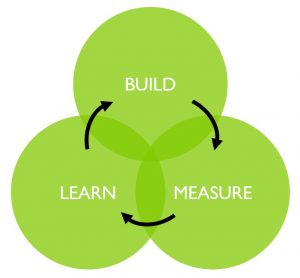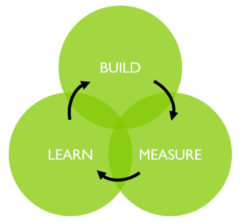
Build-measure-learn feedback loop is the engine that transforms ideas into products or services*. Each iteration will take you one step closer to your goal, each round through the loop will give you invaluable learning about your users, product and customers.
Before going into the build phase, it is critical to have a vision. Vision tells you what is the problem you are going to solve, how you will bring value to the users and customers. Vision gives you the true north, a clear idea where you are going.
In essence, the vision is a series of assumptions. Who are your customers? Or users? Why would they care about your product? What is their problem that you are now solving? How will they discover your product? How much value will they get from using your product? In which ways will they use your product? In the beginning, you don’t have any true answers, just your assumptions.
It is good practice to explicitly write down your assumptions and especially how you can validate them. The goal of your early experiments is to test these assumptions as fast as possible.
Build
Once you know your assumptions, you are ready to start experimenting. From your assumptions, select the most critical uncertainty, and figure out what is the fastest way to get answers. In many cases, you don’t actually have to build to get started.
A great example is to start selling your product before you have actually developed anything. This experience will tell you a lot about how customers perceive the value you are proposing. And, if no-one is interested enough in buying, you have found this out before spending a fortune on developing something nobody wants.
Measure
Sooner or later your will need to build prototypes. While it is very difficult for people to tell what they want before they see it, it’s straightforward to evaluate if something is valuable or not once people can try it out. A prototype in the hands of the users gives you this feedback. Observing people using your prototype is a great learning exercise.
It is all too easy to make prototypes too complex and spend too long time before going to the users. Assumptions and vision help you select what are the most critical things to learn at each step, and you can select the features for the prototypes based on these. It is critical to limit the number of features to the absolute minimum needed to test the assumption you are focusing on with that experiment. Trying to solve too many things at the same time will slow you down.
In the beginning, what you build will be small and light. As development continues, experiments get bigger. Product design happens gradually, in line with experiments. At any moment, focus in design is on the most critical of things at that moment.
Learn
Measurements and learning from the experiment will tell you what are the next things to do. Sometimes the experiment tells your assumption was wrong. The world did not behave the way you anticipated. This is valuable learning and the best part is, since you have chosen the assumption carefully, you have just found out a critical flaw in your plans without investing time and money into something less important. You need to figure out how to change your plans with the new information you have just learned.
In best case, your assumption is validated, at least partially. This is great! Your most critical uncertainty has just been cleared! The next thing is to look at remaining uncertainties and figure out what assumption is the target for your next experiment. Once you have verified all the assumptions, you can proceed ahead at full speed.
*) everything about build-measure-learn applies equally to developing both products and services. For ease of reading, in this article I have simply written “products” instead of “products and services”.
